The Allure of Mango Pudding
The Sweet Tropical Origins of Mango Pudding
Mango pudding didn’t start in a high-end restaurant—it blossomed in Asian kitchens, particularly in Hong Kong, Singapore, and Malaysia. Inspired by British-style custards, this dessert evolved as local chefs infused tropical mango flavor into a silky base of cream and gelatin. Over time, it became a staple in dim sum parlors and home kitchens alike. What I love is how versatile it is. Whether you’re using fresh mangoes or canned pulp, it adapts beautifully while maintaining its vibrant essence.
I’ve noticed how regional tweaks add depth: some recipes use evaporated milk for richness, others swap in coconut milk for a vegan twist. And when served chilled in glass cups, it’s not just a dessert—it’s a showstopper.
Why Mango Pudding Captures Hearts Globally
It’s no mystery why mango pudding is beloved around the world. It’s creamy yet refreshing, sweet but balanced, and easy to make while still feeling fancy. The mango flavor hits differently—bold, sunny, and fragrant. It reminds us of warm days, beachy vibes, and relaxed moments. That emotional connection turns this dish into more than a treat. It’s comfort food, it’s celebration food, and sometimes, it’s what you make when you need a quick lift.
Plus, its golden color naturally stands out, making it a crowd favorite for dinner parties, potlucks, and even afternoon snacks. Paired with textures like chewy tapioca pearls or garnished with nuts and mint, it becomes both a flavor bomb and a visual delight.
Table of Contents
Key Ingredients for the Perfect Mango Pudding
Choosing the Right Mangoes: Flavor, Texture, and Ripeness
Let’s be real—the mango makes or breaks your mango pudding. Over the years, I’ve played with different varieties, and I’ve come to swear by Ataulfo or Alphonso mangoes. Why? Because they’re naturally sweet, low in fiber, and full of rich tropical flavor. They blend into a smooth puree without needing much extra sugar. If you’re using fresh mangoes, make sure they’re fully ripe. A gentle squeeze should give a bit, and the aroma should be unmistakably mango.
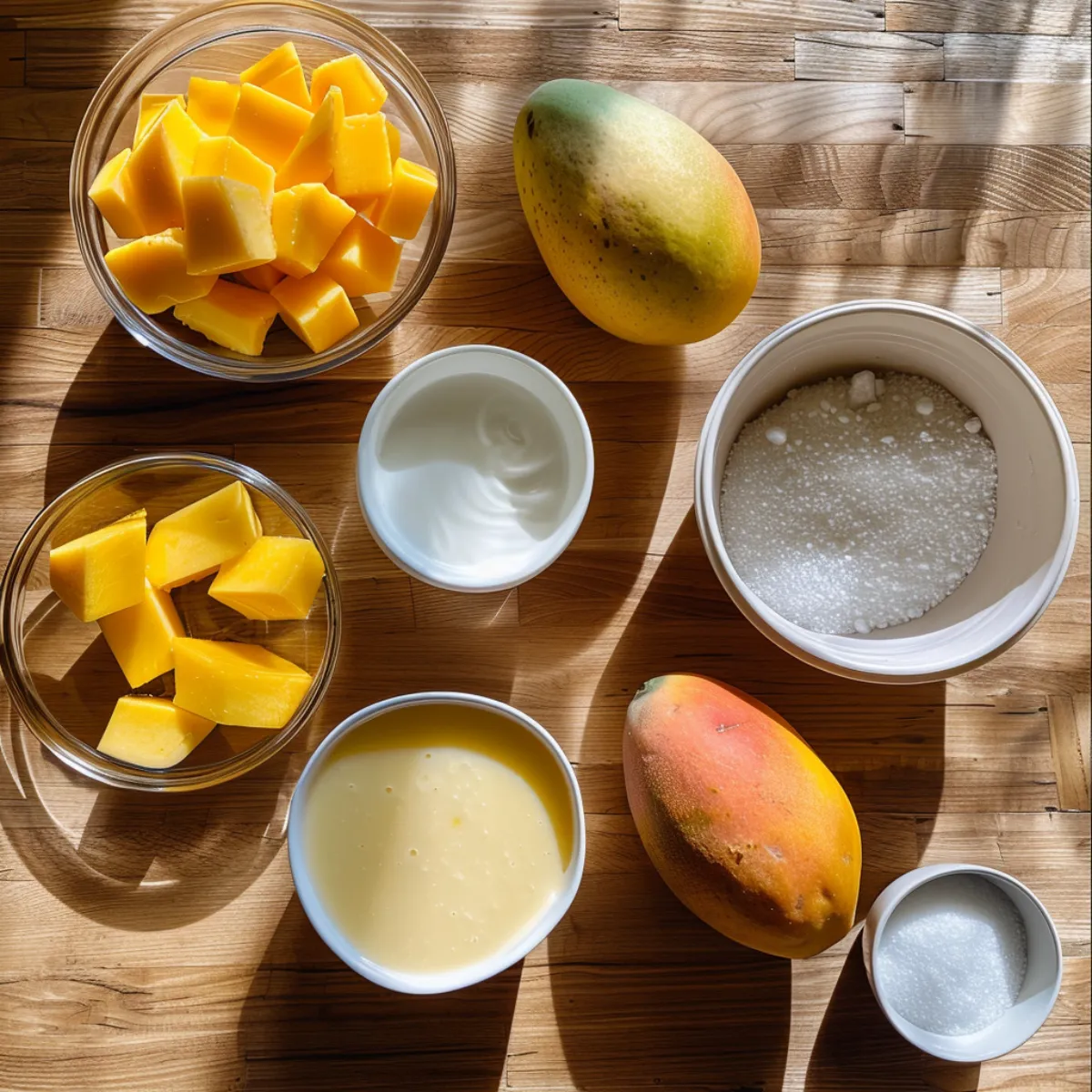
If you can’t find fresh ripe ones, don’t worry—canned mango pulp is a great alternative. It’s consistent and convenient. Just be sure it’s pure pulp with no added flavors or preservatives. I’ve had great results with Indian brands like Kesar or Alphonso pulp.
Pro Tip: Taste your mango or pulp before you start. If it’s overly tart or dull, your pudding won’t shine.
Essential Add-Ins: Cream, Milk, Gelatin, and Alternatives
At its heart, mango pudding is a custard-style dessert, so it needs a creamy base to bind the fruit and give that smooth, melt-in-the-mouth feel. I typically use a mix of heavy cream and whole milk, which gives it just the right balance between richness and lightness.
Then comes the question: to gelatin or not to gelatin? Traditional recipes use unflavored gelatin to set the pudding. About 2 teaspoons of powdered gelatin for every 2 cups of liquid is my go-to ratio. Bloom it in warm water before mixing—this step is key to avoid lumps.
If you’re avoiding animal products, agar-agar is your best friend. It’s a plant-based gelling agent that sets firmer than gelatin. Just note that agar needs to be simmered to activate, unlike gelatin.
Sweeteners are flexible. I often use condensed milk when I want that extra creamy sweetness—it adds both sugar and richness. Otherwise, plain white sugar or even honey (in small amounts) works well.
Flavor boosters? A touch of vanilla extract, a squeeze of lime, or even a pinch of cardamom can deepen the flavor profile without overpowering the mango.
How to Make Classic Mango Pudding at Home
Step-by-Step Method: Traditional Mango Pudding Recipe
Now for the good stuff—how to actually make mango pudding. This is the method I use when I want the classic, creamy, spoon-worthy version that still feels light and tropical.
Here’s my go-to recipe:
Ingredients:
- 2 ripe mangoes (or 1 cup mango pulp)
- 1 cup whole milk
- ½ cup heavy cream
- ¼ cup sugar (adjust to taste)
- 2 tsp unflavored gelatin
- ¼ cup warm water
- Optional: ¼ tsp vanilla extract, mint for garnish
Instructions:
- Bloom the gelatin: In a small bowl, stir gelatin into warm water. Let it sit for 5–10 minutes until it looks like jelly.
- Blend the mango: Peel and dice the mangoes. Puree them until smooth. If you’re using canned mango pulp, no blending needed—just give it a whisk.
- Heat the base: In a saucepan, warm the milk, cream, and sugar over medium heat. Stir constantly until the sugar dissolves. Don’t let it boil.
- Add gelatin: Remove from heat and stir in the bloomed gelatin. Mix well until fully dissolved.
- Combine with mango: Let the mixture cool slightly, then whisk in the mango puree and optional vanilla extract.
- Pour and chill: Pour into serving cups or molds. Chill for at least 4 hours or until set.
The result? A silky, golden mango pudding that holds its shape but melts in your mouth. I like topping mine with diced fresh mango or a mint leaf for contrast.
No-Gelatin & Vegan Mango Pudding Options
If you want to skip the gelatin—maybe for dietary reasons or just because you’re out—I’ve got you covered. I’ve experimented with agar-agar, cornstarch, and even chia seeds, depending on the texture you’re after.
Here’s how to do it with agar-agar (my favorite vegan option):
Ingredients:
- 1 cup mango pulp
- ¾ cup coconut milk or almond milk
- ¼ cup sugar
- 1 tsp agar-agar powder
Instructions:
- Mix the mango pulp and sugar in a bowl.
- In a small saucepan, dissolve the agar-agar in the plant milk. Bring it to a simmer and stir for 2–3 minutes.
- Remove from heat and mix in the mango mixture.
- Pour into molds and let chill until firm—usually in about 1 hour.
Want something more pudding-like and spoonable without using gelatin or agar? Use cornstarch:
- Mix 1 tbsp cornstarch with 2 tbsp water, stir it into your milk-cream mix, then heat until thickened. Add mango puree after cooling.
Creative Mango Pudding Variations
Mango Sago Pudding and Asian-Inspired Twists
Sometimes, the classic just isn’t enough—and that’s where mango pudding variations come alive. One of my favorite versions is Mango Sago Pudding, a texture-rich dessert that’s popular across Southeast Asia.
What’s sago? It’s a type of small tapioca pearl that becomes wonderfully chewy when cooked. I discovered this version during a trip to Kuala Lumpur, where street vendors would layer chilled mango puree with soft, translucent sago and pour over a bit of evaporated milk for good measure.
How to Make It:
- Cook sago pearls in boiling water until translucent, then rinse under cold water.
- Prepare your mango pudding base as usual.
- Layer the sago into serving glasses, pour in the mango mix, and chill.
- Finish with a swirl of coconut milk or evaporated milk on top.
If you love texture, this one’s unbeatable. And it adds an exotic flair without complicating the prep.
Another twist I tried once during a home-cooking session with a Thai friend was mango sticky rice pudding—basically a hybrid where pudding meets glutinous rice. It’s denser and incredibly filling, but it works beautifully for those who want a heartier dessert.
Layered Mango Coconut Pudding and Other Hybrids
Layering mango pudding with coconut cream or passion fruit jelly isn’t just about looks—it changes the flavor experience entirely. Each bite becomes dynamic, tropical, and surprising.
Coconut-Mango Pudding Cups:
- Alternate layers of mango pudding and coconut milk jelly (made with coconut milk and agar-agar).
- Garnish with toasted coconut flakes for crunch.
Mango-Passion Jelly Dessert:
- Add a thin layer of passion fruit jelly on top of your set mango pudding.
- The tartness cuts through the sweetness and gives it a gourmet touch.
One weekend, I even folded whipped cream into the mango base for a mousse-style pudding. It was airy, elegant, and perfect for special occasions.
Tips for Serving and Presentation
Best Containers and Molds for Setting Mango Pudding
Over the years, I’ve realized that how you serve mango pudding matters almost as much as how you make it. Presentation turns a simple mango dessert into something truly memorable.
For a classic look, I love using glass dessert cups or small ramekins. Clear containers showcase the pudding’s sunny hue, and if you’re layering with sago or coconut cream, the visual impact is stunning. For parties, I sometimes go for mini mason jars—they’re cute, portable, and make cleanup easier.
If you want to impress guests, use silicone molds. Once the pudding sets, pop them out onto a plate for a professional, molded look. You can even use heart or flower-shaped molds for themed occasions.
For a rustic, homemade charm, pour it into ceramic bowls or coconut shells (yes, I’ve done that too!). It gives off tropical vibes, especially when paired with natural garnishes.
Garnishing Ideas: Fruits, Nuts, Syrups, and Edible Flowers
Now for the fun part—dressing up your mango pudding. A few thoughtful garnishes can transform your pudding from plain to wow.
Fresh Mango Chunks: Dice ripe mangoes and pile them on top. This adds texture and amplifies the fruity flavor.
Mint Leaves: A fresh green pop against the golden pudding makes every cup look styled.
Toasted Coconut Flakes: Sprinkle for crunch and added flavor depth.
Crushed Pistachios or Almonds: These add color, texture, and a slightly savory note that complements the sweetness.
Coconut Cream Drizzle: A swirl of coconut milk or cream just before serving gives a luxurious finish.
Edible Flowers: Think orchids or violets—perfect for brunches or high teas.
Fruit Syrups or Compotes: Try a passion fruit drizzle or a spoonful of berry compote to balance the mango’s sweetness.
Pro Tip: Serve mango pudding chilled but not frozen. I take it out of the fridge 5 minutes before serving so the flavors shine through better.
What Pairs Well with Mango Pudding?
Drinks, Sides, and Snacks That Complement It
Pairing mango pudding with the right accompaniments can elevate your dessert game like nothing else. When I’m serving it at a dinner party or even just treating myself after a long day, I love curating a small spread around it.
Here are some of my tried-and-true combos:
1. Iced Jasmine or Green Tea:
The subtle floral notes of jasmine or the mild bitterness of green tea cut through the richness of the pudding perfectly. It’s a refreshing match that cleanses the palate.
2. Coconut Water or Sparkling Limeade:
Both offer tropical notes that mirror the mango pudding’s sunny flavors. Coconut water especially keeps the vibe light and beachy.
3. Shortbread Cookies or Biscotti:
Crisp, buttery cookies provide a textural contrast. I often serve a couple on the side when the pudding is in a glass cup.
4. Fresh Fruit Slices (Kiwi, Pineapple, or Berries):
Acidic or tart fruits balance the pudding’s sweetness. I like arranging a few slices around the pudding cup—makes for a vibrant, Instagram-worthy plate.
5. Salted Nuts:
A small bowl of roasted cashews or almonds adds a salty, crunchy note that makes each spoonful of pudding pop.
How to Turn Mango Pudding into a Full Dessert Platter
Want to go all out? Try building a mango-themed dessert board. I did this once for a summer get-together, and it was a total hit. Here’s what to include:
| Dessert Element | Why It Works |
|---|---|
| Mango Pudding Cups | Creamy, centerpiece dessert |
| Coconut Macaroons | Chewy texture, tropical pairing |
| Chocolate Dipped Mango Slices | Sweet and indulgent |
| Mini Matcha Muffins | Earthy counterbalance |
| Pineapple Skewers | Tangy and juicy touch |
| Mint or Lime Garnish | For aroma and freshness |
When you curate textures—creamy, crunchy, juicy—and flavors—sweet, tangy, nutty—you create a full-on experience. That’s what makes dessert memorable.
Nutritional Benefits of Mango Pudding
Vitamins and Nutrients in Mangoes and Cream
You might be wondering—is mango pudding just a sweet treat, or does it actually have nutritional value? Good news: mango pudding isn’t just about indulgence. If made mindfully, it delivers a decent dose of vitamins, minerals, and natural energy.
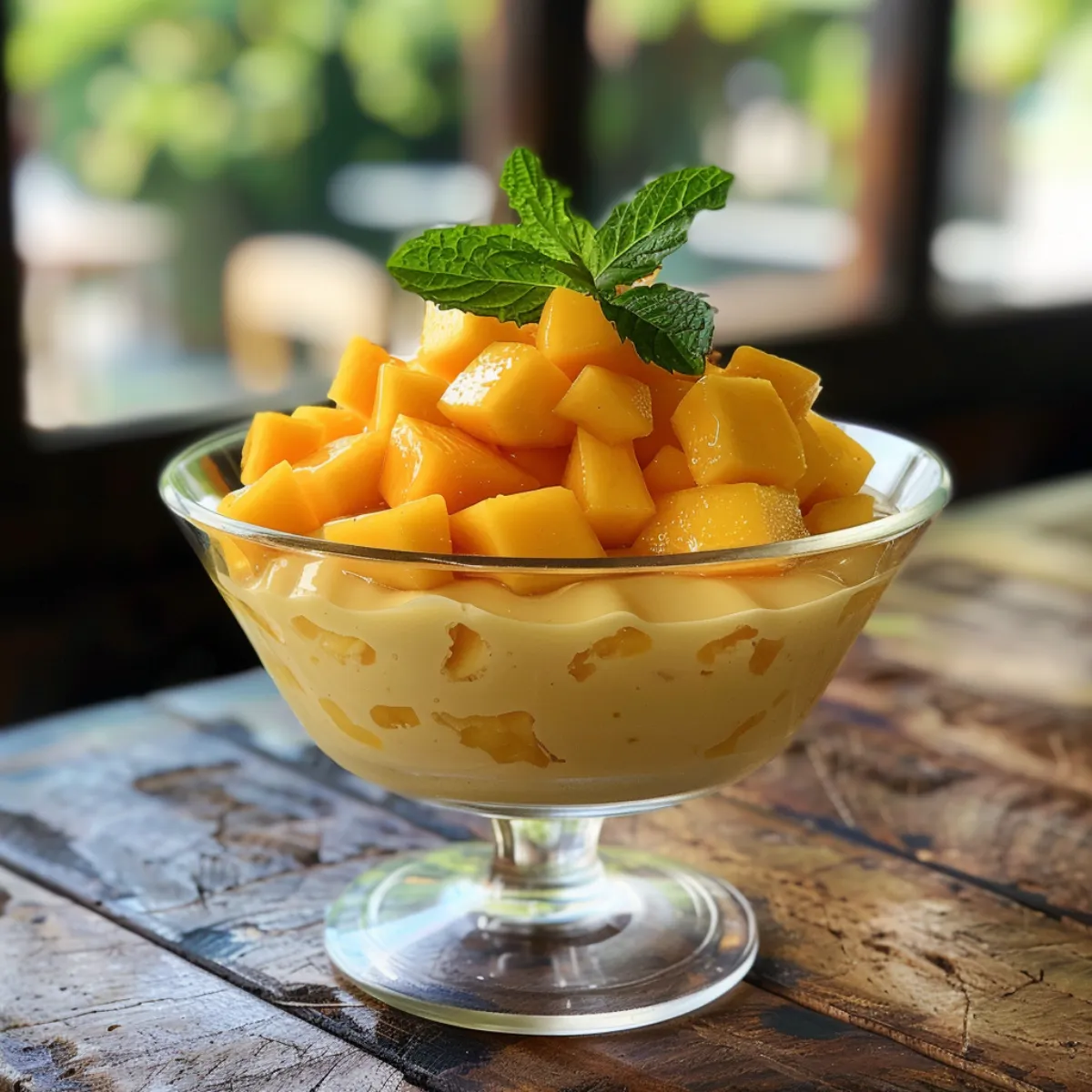
Mangoes are the real star here. They’re packed with:
- Vitamin C – Supports immune function and skin health.
- Vitamin A – Great for vision and skin.
- Fiber – Helps with digestion.
- Antioxidants – Like beta-carotene and mangiferin that fight inflammation.
One cup of fresh mango provides almost 70% of your daily Vitamin C needs. That’s no small feat for a dessert!
If you’re using fresh cream and whole milk, you’re also getting:
- Calcium – Essential for bones and teeth.
- Vitamin D – When using fortified milk.
- Healthy fats – Which help absorb the mango’s fat-soluble vitamins.
And don’t underestimate the mental wellness factor. Sometimes, a cold spoonful of mango pudding is the perfect emotional reset.
Is Mango Pudding Healthy? Calories, Sugar, and Balance
Let’s be honest though—traditional mango pudding isn’t a low-calorie snack. Depending on your ingredients, a standard serving can range from 180 to 300 calories, with sugar playing a major role.
Here’s a quick nutrition snapshot for a standard ½-cup serving made with whole milk, cream, and sugar:
| Nutrient | Approx. Value |
|---|---|
| Calories | 210–250 kcal |
| Sugar | 20–25g |
| Fat | 10–15g |
| Carbs | 25–30g |
| Protein | 3–4g |
But that doesn’t mean you can’t tweak it:
- Use coconut milk or almond milk to lower fat and dairy.
- Swap sugar for honey, stevia, or maple syrup in moderation.
- Add chia seeds for extra fiber and omega-3s.
Everything comes down to balance. I make mango pudding as a weekend treat or a shared dish—not an everyday dessert. That way, I enjoy it fully, without guilt.
Frequently Asked Questions
Does mango pudding have gelatin?
Yes, traditional mango pudding recipes usually include unflavored gelatin as the setting agent. Gelatin gives it that soft, jiggly texture that holds its shape yet melts in your mouth. I typically bloom 2 teaspoons of gelatin in warm water before stirring it into the warm milk-cream mixture.
That said, many modern or vegan versions skip gelatin and use agar-agar (a seaweed-based gelling agent) instead. It sets more firmly and is completely plant-based. You can also experiment with cornstarch or chia seeds, though the texture won’t be exactly the same.
So, while gelatin is commonly used, it’s absolutely possible to make mango pudding without it.
What goes well with mango pudding?
Mango pudding is versatile and pairs beautifully with both drinks and other desserts. I often serve it with:
Iced jasmine tea or green tea to cleanse the palate.
Fresh berries, kiwi, or pineapple for a tangy balance.
Crisp cookies like biscotti or shortbread.
Coconut milk drizzle or toasted coconut flakes.
Crushed pistachios or almonds for crunch.
How to make mango pulp pudding?
Mango pulp pudding is one of the easiest variations. Here’s my go-to method when I use canned mango pulp:
Ingredients:
1 cup mango pulp (Kesar or Alphonso works best)
½ cup milk (or coconut milk for a dairy-free version)
¼ cup condensed milk
2 tsp gelatin (or 1 tsp agar-agar for vegan version)
¼ cup water to bloom gelatin
Steps:
Bloom the gelatin in water.
Warm the milk and condensed milk together, then stir in the gelatin.
Add the mango pulp and mix thoroughly.
Pour into serving cups and chill for 4+ hours.
This version is rich, smooth, and even easier than the fresh mango one because there’s no blending involved.
What are the benefits of eating mango pudding?
Mango pudding isn’t just delicious—it can also be lightly nourishing, especially if made with real mango and minimal sugar.
Benefits include:
Rich in Vitamin C and antioxidants from mangoes
Provides quick energy from natural sugars
Supports digestion thanks to mango’s fiber content
Contains calcium (if using milk or cream)
And let’s not forget the emotional lift a cool, fruity dessert brings on a hot day. When made at home, you can control the ingredients to keep it light, fresh, and relatively guilt-free.
Cultural and Personal Reflections
Mango Pudding Memories from My Travels in Southeast Asia
It wasn’t until I set foot in Hong Kong on a humid July evening that I truly understood what mango pudding could be. I wandered into a tiny dessert café tucked away behind a row of neon-lit shops. I ordered the house special—mango pudding with sago and coconut milk—and sat by a foggy window while the rain tapped on the glass. The first bite was magic. It was chilled, silky, and the mango flavor was so bright, it almost felt like eating sunshine.
That moment lingered with me long after I flew home. I started experimenting in my kitchen, trying to replicate that exact balance of richness and freshness. It was never quite the same—but every version came with its own story.
Mango pudding, for me, is more than a dessert. It’s a time capsule. It’s the shared laughter over Sunday lunch, the quiet comfort after a hard week, the joy of creating something with your own hands. It reminds me how powerful food is in connecting us to people, places, and even parts of ourselves we forgot were there.
Sifaw’s Twist: A Family-Inspired Recipe Story
A few years ago, I introduced my family to mango pudding at our annual summer BBQ. My niece was skeptical—“Is it like Jell-O?” she asked. I said, “It’s better.” She took a bite, paused, then grabbed a second cup before finishing the first.
That night, I made a slight change to the recipe. I blended in a touch of coconut cream and topped it with crushed pistachios and cardamom. My mom said it reminded her of the mango kulfi she used to eat as a child in North Africa. And just like that, our mango pudding became a fusion of heritage and discovery.
It’s now a summer staple. Whenever mango season rolls around, someone in the family asks, “Are you making the mango pudding?” And I always do.
Follow me on Facebook for updates and recipe experiments: https://web.facebook.com/profile.php?id=61574017187063 and Pin this and explore more sweet ideas on Pinterest: https://www.pinterest.com/heartlyrecipes/
Print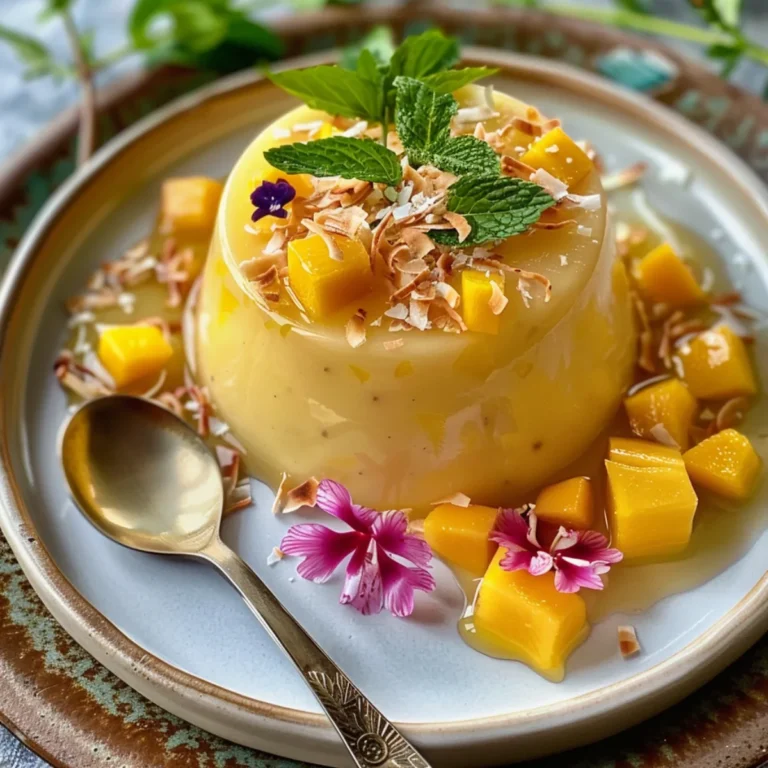
Mango Pudding Recipe Guide: Creamy, Tropical & Irresistible
A silky, tropical dessert with rich mango flavor and a creamy, melt-in-your-mouth texture. Perfect for warm days or when you want a sweet, fruity escape.
- Total Time: 20 minutes + 4 hours chill time
- Yield: 4 servings 1x
Ingredients
- 2 ripe mangoes (or 1 cup mango pulp)
- 1 cup whole milk
- ½ cup heavy cream
- ¼ cup sugar (adjust to taste)
- 2 tsp unflavored gelatin
- ¼ cup warm water
- Optional: ¼ tsp vanilla extract, mint for garnish

Instructions
- Bloom the gelatin: In a small bowl, stir gelatin into warm water. Let it sit for 5–10 minutes until it looks like jelly.
- Blend the mango: Peel and dice the mangoes. Puree them until smooth. If using canned mango pulp, whisk instead.
- Heat the base: Warm the milk, cream, and sugar in a saucepan over medium heat until sugar dissolves. Do not boil.
- Add gelatin: Remove from heat and stir in the bloomed gelatin until fully dissolved.
- Combine with mango: Let mixture cool slightly, then whisk in mango puree and optional vanilla extract.
- Pour and chill: Pour into serving cups or molds. Chill for at least 4 hours until set.
Notes
Use ripe Ataulfo or Alphonso mangoes for best flavor. For a vegan version, substitute gelatin with 1 tsp agar-agar powder and use coconut or almond milk.
- Prep Time: 15 minutes
- Cook Time: 5 minutes
- Category: Dessert
- Method: Chill
- Cuisine: Asian-Inspired
Nutrition
- Serving Size: 1 serving
- Calories: 230
- Sugar: 22g
- Sodium: 45mg
- Fat: 11g
- Saturated Fat: 7g
- Unsaturated Fat: 3g
- Trans Fat: 0g
- Carbohydrates: 28g
- Fiber: 1g
- Protein: 3g
- Cholesterol: 30mg
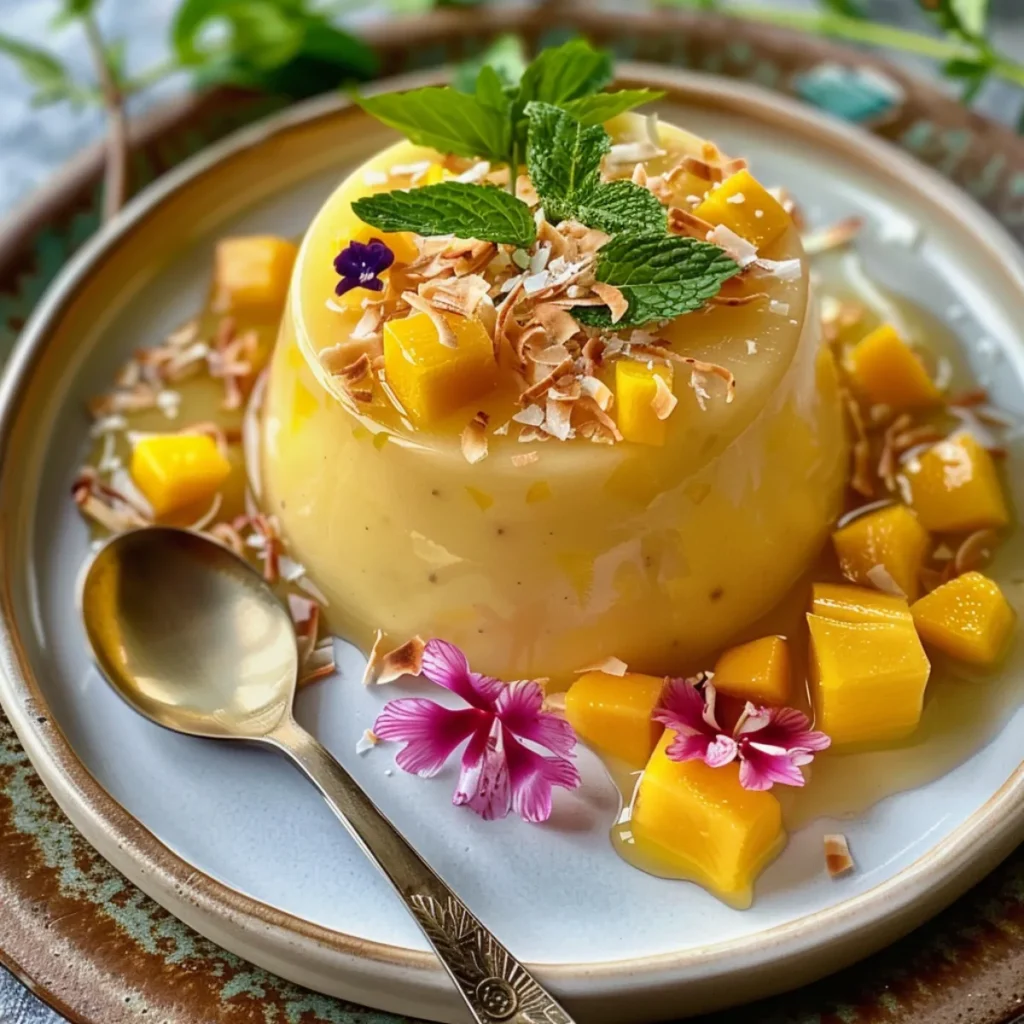


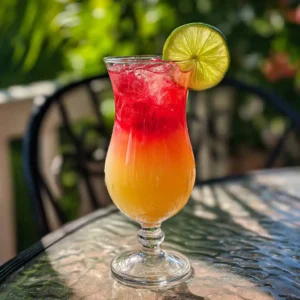




2 thoughts on “Mango Pudding Recipe Guide: Creamy, Tropical & Irresistible”